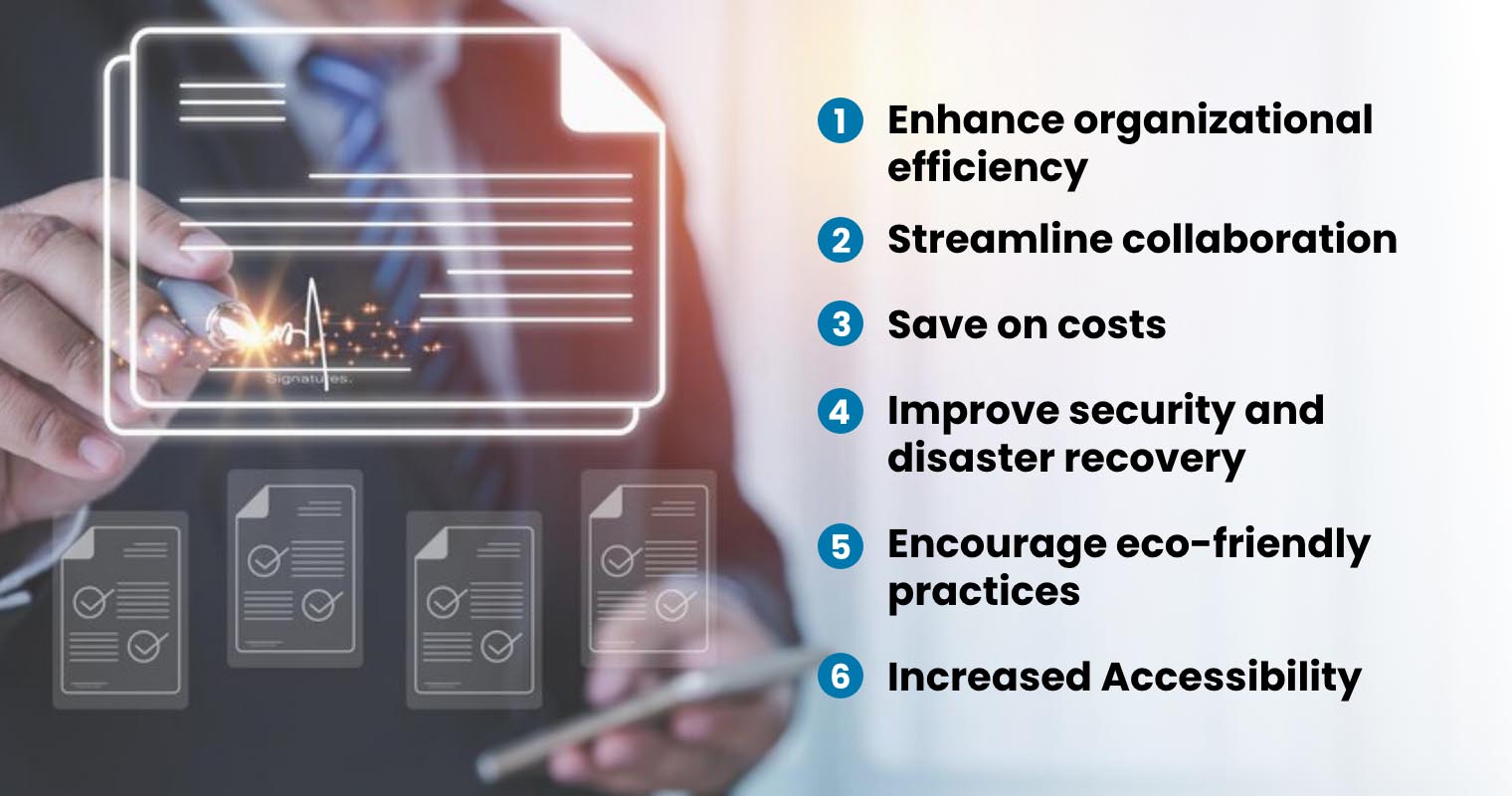What does it mean to go “paperless”? Most organizations imagine a paperless setup as the outright removal of pulp and paper from their day-to-day processes. However, this can also refer to a great reduction, rather than the absolute removal, of paper use. Whichever is more suitable for business purposes, both entail the provision of alternatives to physical paper which has been primarily addressed by digitization — the process of converting physical documents into electronic files and migrating activities to the digital platform. A paperless office can therefore be defined as one that conducts its business digitally, whether wholly or to a great extent, for various good reasons.
Besides corporate social responsibility, the trend of going paperless at work presents opportunities to calibrate and enhance one’s business procedures. It can, for instance, declutter physical space and improve workflow that might otherwise prove to have become inefficient.
This article will discuss the benefits of going paperless and some of the ideal practices an organization can take in transitioning to a paperless setup, such as the integration of a board portal in executive meetings and how to go paperless at work.
The Benefits of Going Paperless

The post-pandemic situation has arguably seen organizations of varying sizes opening up to the potential of going paperless, an option that may well become a mainstay for companies seeking to optimize their workspace. In addition to economic considerations, being paperless provides many advantages that outweigh certain aspects of the traditional paper-based office. Below are six benefits to give you an idea of what a paperless setup can offer and the value it may add to your company.
1. Enhance organizational efficiency
There is no denying that producing and reproducing physical documents is necessary for certain requirements such as legal or official sufficiency. Business records that do not fit this category, however, are arguably easier to handle and store electronically, especially in consideration of their scale. The more hardcopy documents an organization produces, the more physical space it takes up to file them, and the more traffic it takes to maintain their storage and retrieval. All these eventually add up to a reduction of efficiency that, in turn, results in a reduction of productivity.
Problems with information retrieval can therefore be minimized, if not totally resolved, by going paperless at work. If left unaddressed, retrieval systems can gradually become the bane of organizations using large quantities of paper. As they accumulate and render longer turnaround times, not only can paper cause a business to suffer, but it can be vexing as well to the employees who manage them. With these in mind, it can be strategic to switch to digital to conserve more time and effort. These paperless benefits can contribute to enhanced and long-term efficiency of the organization.
2. Streamline collaboration
The global crises and the shift to virtual have shown us that long-distance collaboration is not only possible but ideal for teams with remote members. Indeed, virtual business gatherings have become far more common, with executives now hosting board meetings purely online with the help of powerful software. This flexibility afforded by going paperless, meaning the ability to hold professional meetings whenever or wherever one is based, certainly has advantages over less versatile ways of sharing information such as the use of board packets and papers.
Other collaborative benefits of going paperless are the option for increased modality, control, and mediation. Through digital tools, a company can amend, modify, and sign documents on the go, which can then be cascaded to all collaborators instantaneously. Moreover, communication in a digital setup is often streamlined, enabling management to control who can speak, to whom, how, and when. In other words, a paperless collaboration allows more people to participate with less or the same amount of resources, and by doing so, reduces overhead costs.
3. Save on costs
The use of paper is arguably not cost-efficient — the price of paper is steadily rising and is expected to continue increasing in the years to come. By opting for a paperless document management system, you circumvent the problem of paper prices and its associated expenses such as printers, printer ink, printer maintenance, and other office supplies. Combined, the overhead cost from these can be staggering as they quickly add up.
Compared to paper, the expenses you will ever need for out-of-the-box software will generate you a higher ROI. As paper is fast becoming, if not already, an expensive commodity, instead of spending on it, you can save more for your business by allocating resources to other value-adding processes.
4. Improve security and disaster recovery
Paper and physical documents are prone to accidents such as fires and other hazards. In consideration of these risks, it has become standard procedure for many organizations, including paper-oriented entities such as libraries, to digitize their records and preserve them for posterity. This benefit of redundancy addresses issues of recovery. However, their storage should also be protected from breaches and unpermitted access just as much as physical repositories are secured from theft.
This should not be a problem since most paperless software are equipped with optimally designed security functions. In some cases, a complete migration of physical documents to electronic repositories may even be desired for enhanced security. While counterintuitive, storing all business records in digital format forgoes the need for shredding documents, a method that is less ideal when security and confidentiality are a top priority. With paperless document management software, the same data erasure procedure can be done with very minimal to no trace.
5. Encourage eco-friendly practices
Perhaps one of the most ubiquitous reasons for going paperless, sustainability is among the most compelling benefits of going paperless at work. There have been apparent predictions that in the modern age, paper use will eventually become obsolete in favor of digital media.
Cutting down on paper therefore gives a company the opportunity to take part in protecting the planet by reducing the demand for paper whose production, driven by deforestation, contributes to greenhouse emissions and waste. Paperless office software is more sustainable than paper not just in terms of waste but also usage; a single sheet of paper can only accommodate so much data whereas the “space” in a digital file can be virtually scaled indefinitely.
While a total removal of paper may not be feasible for every organization, reducing paper consumption can be achieved by reviewing and recalibrating business procedures that can actually be carried out without the paperwork.
6. Increased Accessibility
Lastly, going paperless can be a step towards inclusivity. By virtue of being digital, paperless office software can be integrated with features that can aid people with visual or hearing impairments. Narration, closed captioning, and chat-based communication give people with disabilities more latitude in collaborating and engaging. Known as assistive technology, these provisions for accessibility are a benefit that is not possible with traditional paper.
Paperless office software can also be advantageous for everyone, not just individuals with disabilities, through features that improve productivity. Translation, for instance, can be utilized to read digital documents written in a different language, among other tasks that traditionally take time to process. Moreover, accessibility also encompasses people who are not used to technology. Ironically, digital solutions now prioritize user interfaces to be made accessible for individuals with varying technological experiences.
How to Go Paperless at Work: Transitioning from Paper-Based Processes to Digital
The six paperless benefits discussed above have broached the ways how to go paperless at work. Your transition from paper-based processes to digital can mean the difference between a stifling work environment and a flourishing one. Below are simple steps to get you started.

- First, drop the physical filing of paper and instead store them using a paperless document management system. This will free up space in your office and improve efficiency.
- Collaborate through digital means that engage people just as much as traditional platforms. This includes hosting board meetings and discussions virtually with the use of powerful software.
- Cut the added expenses that come with paper such as printers to save on costs. Instead, allocate resources to more value-adding processes.
- In keeping with company policies, migrate information to electronic format to ensure confidentiality when deleting or removing data. This is much more secure than manually shredding documents.
- Start by reducing paper in your office slowly and feasibly instead of forcing your company to adopt a total paper-free policy. By doing so, you take steps toward sustainability and help conserve the planet.
- Consider the needs of each employee in your company. Assess if everyone is able to have equal access to engaging with your business. If not, look at the opportunities where going paperless can actually benefit certain people such as those with visual or hearing impairment.
Frequently Asked Questions about Going Paperless
Is it difficult to transition to a paperless system?
It depends on the scale and nature of your company. Paper-oriented companies may find it more difficult to shift to a paperless setup than digital-oriented companies. More often than not, company culture will also play a significant factor in this regard. While it can take time, transitioning to a paperless office can be done without major problems provided that change management is implemented carefully. Some of these transitional challenges can be anticipated beforehand to rule out obstacles.
Can going paperless save businesses money in the long run?
Yes. Among the most advantageous paperless benefits, getting rid of paper boils down to the value it adds to the company in terms of ROI. By eliminating costs associated with paper, you can allot more of your resources to other value-adding processes. And with the increasing price of paper, going paperless can save your company money in the long-term.
Are digital documents secure from data breaches?
The risk of a data breach in any given company depends on various factors ranging from employee security awareness to the integrity of the software being used itself. In any case, data breaches are rare for companies that implement strict policies on data security. This means that digital documents in such environments are being handled with just as much care as if they were managed physically. Additionally, several high-quality software with excellent track records are available on the market for businesses to vet and evaluate.
Are there any legal considerations when going paperless?
Some digital documents fall inferior to physical documents when it comes to official and legal sufficiency. Contracts, for instance, are legally binding on the basis of wet signatures in the majority of jurisdictions around the world. For internal processes, however, a company ultimately decides on what practices are deemed acceptable or even ideal to move to digital and which, like legal requirements, are better off done on physical paper.
In the end, the most important takeaway from going paperless is maximizing productivity, and if legality is a concern, attaining the right balance between paperless and paper-based processes is key.
How Board Portal Can Help You Go Paperless

Of all the ways how to go paperless at work, perhaps one of the most convenient processes is to integrate board portals into your meetings. Designed not just to assist but enhance executive governance, board portals such as Convene provide directors with the capacity to collaborate seamlessly with the added benefit of digital productivity.
Convene offers agenda-building tools to streamline meeting pack preparation and prevent the costs of paper-based agenda packs and dispatch. The software also caters to virtual meetings and paperless document management with review and annotation tools readily available. Moreover, all information is secured in a centralized and resilient document hub.
Take on your paperless and digital work journey with Convene. Learn how its features can enhance collaboration and empower digital governance.
Audrey is a Content Marketing Specialist at Convene, in charge of managing the production of quality content on the company’s website. A communication major keen on marketing, Audrey has been constantly seeking approaches to create tailored content—may it be about governance, digitalization, boards, or meetings—fit for the stakeholders. When not strategizing on the next ebook to produce, Audrey finds solitude in reading make-you-ugly-cry novels and listening to self-improvement podcasts.










